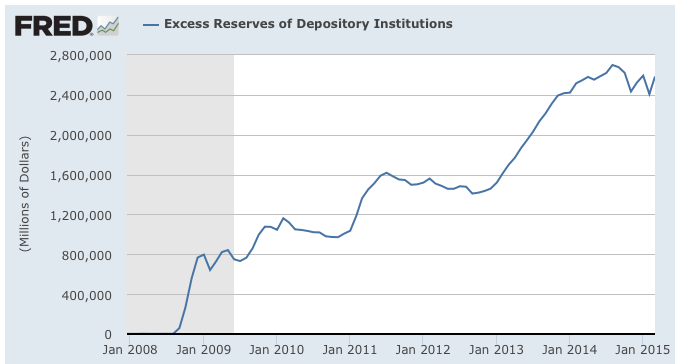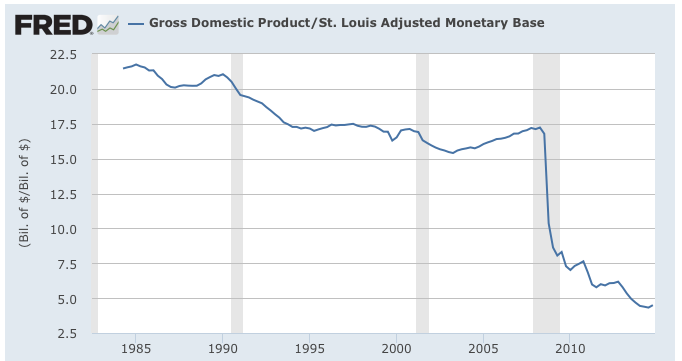This article was last updated on April 16, 2022
Canada: ![]() Oye! Times readers Get FREE $30 to spend on Amazon, Walmart…
Oye! Times readers Get FREE $30 to spend on Amazon, Walmart…
USA: ![]() Oye! Times readers Get FREE $30 to spend on Amazon, Walmart…As a rule of thumb, there is a relationship between the supply of money and prices but it is obviously not as simple as one might expect, particularly given the Federal Reserve's intervention in the so-called free market economy.
Oye! Times readers Get FREE $30 to spend on Amazon, Walmart…As a rule of thumb, there is a relationship between the supply of money and prices but it is obviously not as simple as one might expect, particularly given the Federal Reserve's intervention in the so-called free market economy.
The quantity theory of money states that:
MV = PY
where M is the supply of money, V is the velocity of money circulation (i.e. how many times a dollar changes hands in the economy), P is price level and Y is national income which can also be thought of as the number of transactions that take place. The quantity theory of money assumes that an increase in M causes an increase in P if V and Y are held constant. In the real world, however, the velocity of money can vary greatly as the economy is now experiencing.
Let's look at a very basic example. The economy produces 1000 units and the supply of money is $10000, this means that the average price of each unit will be $10 (if we hold the velocity of money and the national income constant). If the central bank increases the supply of money to $15000 and we hold the production at 1000 units, people have more cash so they are willing to spend more on each item which will result in a price increase to $15 per unit.
Let's look at the real world. Here is a graph from FRED showing how the monetary base has increased since the beginning of 2008:
The monetary base has risen from $852.7 billion in early 2008 to its current level of $4.167 trillion, an increase of $3.314 trillion or 488.7 percent.
What has happened to all of this "money" and why has there been no inflation? Here's a hint:
In January 2008, the U.S. commercial banking sector held an insignificant $1.648 billion in excess reserves at the Federal Reserve. This has mushroomed to $2.584 trillion in March 2015. Why has there been such an increase in money that is just sitting at the Federal Reserve collecting dust? Actually, the commercial banking sector has the Federal Reserve to thank for this; on December 16, 2008, the Fed announced that it would take the unprecedented action of paying 0.25 percent interest on the banking sector's excess reserves for this reason:
"The payment of interest on excess reserves will permit the Federal Reserve to expand its balance sheet as necessary to provide the liquidity necessary to support financial stability while implementing the monetary policy that is appropriate in light of the System’s macroeconomic objectives of maximum employment and price stability."
By paying interest on excess reserves, the Federal Reserve claims that it can better control interest rates in the future. However, what it means is that the banking sector is flipping the increased supply of money right back into the Federal Reserve and collecting roughly $6.46 billion in annual interest for the privilege of not lending this money to both Main Street and Corporate America.
Here is a graph showing the difference between the monetary base and the banking sector's excess reserves (i.e. the amount of new money that has actually made it into the economy since early 2008):
This shows us that relatively little of the new money has made it into the economy, for instance, by February 2015, "only" $608.1 billion of the $3.314 trillion of the monetary base expansion is circulating in the economy. The banks are sitting on the rest, quite content to let the Fed hold onto one huge pile of excess reserves.
Now, let's take a brief look at the velocity of money, a measure of how quickly a dollar circulates through the economy or the ratio of nominal GDP to the supply of money:
At the end of 2014, the velocity of money was 4.49, very slightly above its 32 year low of 4.32 experienced in Q3 2014 and less than one-quarter of the velocity seen just prior to the Great Recession. The current velocity of money is also substantially below its 32 year average of 15.7. If we look back at the MV = PY equation, we can now see why there is no inflation.
If we put all of this information together, it becomes quite clear why, despite the increase in the monetary base, there has been no official inflation (even though consumers real world experience would suggest otherwise). Unfortunately, at some point, the Federal Reserve may rescind its unprecedented policy of paying interest on the banking sector's unnecessary hoarding of excess reserves, a move that has the potential to flood the economy with dollars, pushing up M1 and the velocity of money at the same time, unleashing the hounds of inflation. According to Lawrence Kotlikoff back in 2013, if banks were to fully lend out their reserves and the velocity of money returns to a relatively tame 10.4, there will be enough M1 to support a nominal GDP that is 3.5 times larger than it is now…in other words, the economy will have the potential to see a near quadrupling of prices, a scenario that would be very painful to consumers.
Click HERE to read more of Glen Asher's columns
You can publish this article on your website as long as you provide a link back to this page.





Be the first to comment